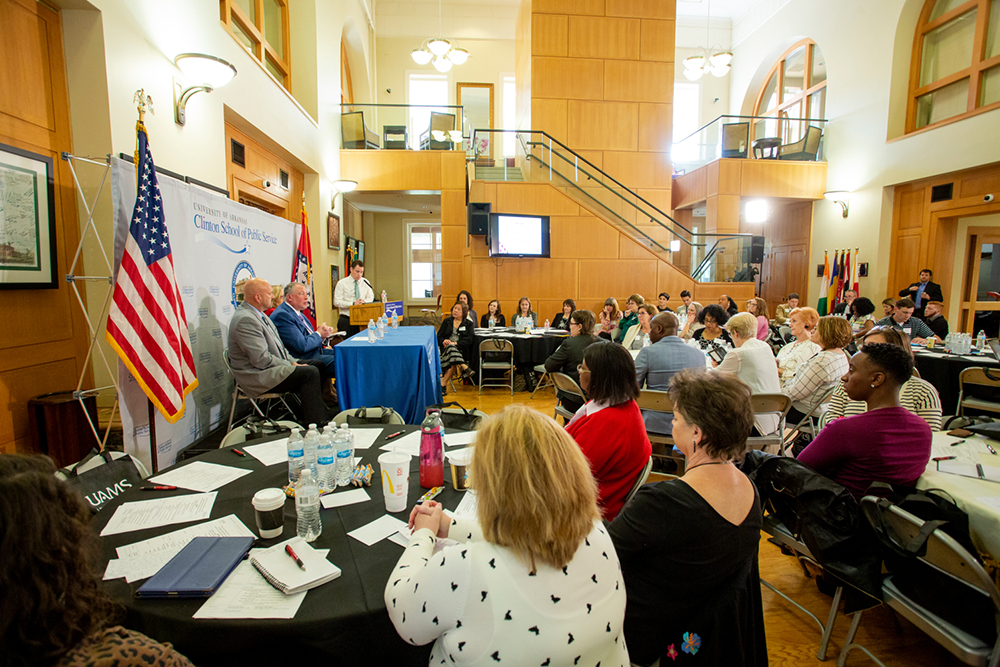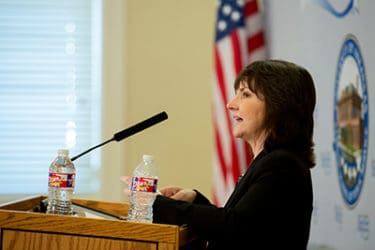UAMS Arkansas Geriatric Education Collaborative, Clinton School Address Opioid Crisis
| April 18, 2019 | Arkansas has the second highest prescribing rate for opioids of all the states, 102.1 opioid prescriptions for every 100 people, and the public health crisis it has caused is affecting every Arkansan from newborns to the elderly.

Masil George, M.D., left, shakes hands with a volunteer at the end of a roleplay exercise demonstrating how to talk to patients and older adults about their opioid use.
This crisis was the focus of “Combating the Opioid Crisis and Chronic Pain,” an event April 12 sponsored by the UAMS Arkansas Geriatric Education Collaborative and the Clinton School for Public Service.
Robin McAtee, Ph.D., R.N., director of the Arkansas Geriatric Education Collaborative, opened the event that drew 65 older adults, health professionals and people with chronic pain to Sturgis Hall in downtown Little Rock.
Kirk Lane, Arkansas drug director, used the statistics above and others to describe to the audience the scope of the problem.
“The national average of opioid prescriptions per 100 people is 58,” Lane said, adding that

The panel of experts at the event, left to right, are Lane Kirk, Michael Mancino, Teresa Hudson and Masil George, David Lippman, far right, moderated.
Arkansas has the fastest rising rate for babies born to mothers who used opioids during pregnancy.
Lane was part of a four-person panel moderated by David Lippman, reporter and weekend anchor for THV 11 television station. Also participating were: Michael Mancino, M.D., director of the UAMS Center for Addiction Services and Treatment; Teresa Hudson, Pharm.D., Ph.D., director of the UAMS Division of Health Services Research; and Masil George, M.D., director of the Geriatric Palliative Care program in the Department of Geriatrics.
Although the opioid crisis affects mother, newborns and young people, older Arkansans also have been touched by it. Naloxone, also known by the brand name Narcan, is a drug that can completely or partially reverse an opioid overdose.
“A lot of people think the only people who need Narcan are heroin addicts and fentanyl addicts,” Mancino said. “That’s not true. In fact, I would argue that anybody who has a prescription for opioids should have it, and I would stress the elderly population is more at risk because they often have co-occurring disorders that make lower doses of opioids potentially fatal.”
Mancino said a low dose of an opioid might be enough to kill a grandmother with chronic obstructive pulmonary disorder (COPD) because her respiratory condition already is weak.
“Having Narcan available for anyone who has a prescription is something we need to move toward as a society,” he said.
George said the way physicians and other health care professionals view pain medications like opioids has changed in the last several years. While some older patients have been using opioids for 10 years or more without serious problems, others haven’t been as lucky.
“Sometimes they approach their pain from a false premise that because they have chronic pain, they will take all the pain medications they need to control it, and there is no other way to manage pain,” George said.
Whether to manage chronic pain in older patients with opioids depends very much on the patient’s overall health. George said an older adult who is active and still drives may be able to manage their pain through things like physical therapy and other non-opioid prescription medications. However, if someone is frail and hasn’t been responsive to those alternatives, or is nearing the end of life, then opioids might be an option.
The risk of overdose may be higher with some older patients because with age, body composition changes and fat composition changes. Opioids can be stored by the body in fatty tissue and further enhance the effect of a strong dose or even the same dose they always have taken. That in turn can adversely affect balance and lead to falls and injury, George said.
In addition to the use of opioids to treat older Arkansans, the panel also talked about recognizing the differences between sudden onset pain and ongoing pain; problems such as dependence, tolerance and addiction; symptoms of addiction; the difference between misuse and abuse of a drug; and that, for some, opioids may actually worsen pain. The panel also discussed public health efforts targeting opioid abuse. The audience watched a short video about an opioid addict’s struggle to recover and several role play scenarios led by George meant to illustrate how to talk to patients and families about opioid addiction and treatment options.
Heejung Choi, M.D., assistant professor in the UAMS College of Medicine’s Department of Anesthesiology and a pain medicine specialist, and Kristin Garner, assistant professor in the UAMS College of Medicine Department of Family Medicine, both gave presentations about their specialties and treating patients with chronic pain.
The UAMS Arkansas Geriatric Education Collaborative is funded by a $3.2 million grant from the Health Resources and Services Administration’s Geriatric Workforce Enhancement Program. The collaborative received a supplemental grant in 2018 to provide opioid education. To achieve the goal of the supplemental grant, it organized the event and developed the Chronic Pain Book in collaboration with the UAMS Center for Health Literacy.
The Pain Books are meant to educate readers about opioids, non-opioid pain alternatives and chronic pain and give them a place to log a pain journal, medications and questions to ask their doctor during visits.

